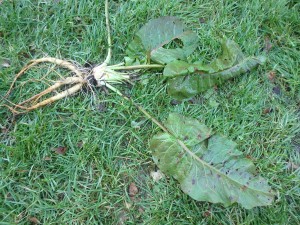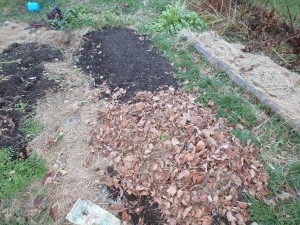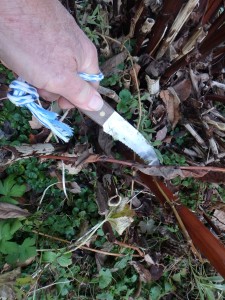Putting the Garden to Bed
Each year about now I suddenly realize that I should have already finished putting my garden to bed. This year I had a good excuse: I’d gone to France to hike, and was away for 3 weeks. But in other years my excuse has been the weather, or finishing a book that I was writing. You get it … I can be a bit of a procrastinator. Most of us are. But if you haven’t finished cleaning up your gardens yet, now is the time to get to work. Winter is just around the corner.
First, and most important to me, is to clean up the vegetable garden and get rid of weeds. I mulch heavily with newspapers and mulch hay, but there are still weeds present. Last week I raked off any newspapers my hungry earthworms had not eaten, and the rotting mulch hay on top. Then I dug out my weeds and lugged them away. Because of the mulch, weeding was not too time-consuming.
I did have some deep rooted weeds, mainly dock (Rumex spp.). The roots of this weed can easily go a foot deep in the first year. So I couldn’t just pull them, even with my favorite weeding tool in hand, the CobraHead weeder. They are a job for a garden fork. I push down on it with my foot, and the four tines go down a foot in the soil. I pull back, and it loosens the soil and lifts the roots a little. Then I am able to tug it out, roots and all. Later I will cover the beds with chopped leaves.
A buddy of mine called recently from Maine asking what to do with the leaves in their flower beds. Should he rake them out now or in the spring? I know a gardener who rakes all her leaves out onto the lawn, runs them over with the lawn mower, bags them up while nice and dry, and then stores them on the barn until spring. She cuts all her perennials down in the fall, too. Then, once the plants have all appeared in the spring, she mulches with the same leaves that were there in the fall.
That method works fine and the added organic matter from all those chopped leaves have built up her soil beautifully over the years. The chopped leaves hold in moisture and keep down weeds. But it’s a lot of work.
My approach is the Lazy-Boy way. I leave the leaves in place now – and in the spring, too, unless they are choking out small plants or covering something special. As a matter of aesthetics, if you don’t like the look of leaves, rake them up. Otherwise, leave them be and they will break down over time.
I will try to cut down most flowers before the snow flies. I leave some things with seeds for birds, sunflowers and black-eyed susans, for example. Instead of using hand pruners, I use a special serrated “root knife” that, unfortunately, is no longer commercially available. When I lose the last of my root knives, I’ll just use a steak knife – or find another manufacturer of the root knife, which has a nice curve to it. Why a knife? Cutting down hundreds of stems is tiring on the hands if using pruners.
You could also use a string trimmer or even a lawn mower to cut everything down. I have one long flower bed that I call my “Darwin bed”. It is full of tall flowers that can compete with the weeds – and each other. Asters, goldenrod, Joe-Pye weed, tall phlox, turtlehead and more compete for space. If a plant doesn’t survive, something else will fill up the space. In the fall I usually just run over it with my riding lawn mower, making it neat and tidy for a few minutes in the spring.
Another fall task involves improving the soil. I recently had my soil tested by Logan Labs (www.loganlabs.com). Their basic test gives a lot of information: pH, percentage of organic matter, mineral contents, trace mineral levels and more. As a member of the Bionutrient Food Association (http://bionurient.org), I was able to get recommended levels of minerals and trace minerals for top quality production, and what (and how much) to add. Of course, each state offers soil testing through their Cooperative Extension service.
My soil is excellent, but needs a little tweaking. Boron, for example, is a little low, as are my potassium levels. I will make some additions this fall so that the added minerals can be incorporated into the soil over the fall, winter and spring. Green sand, a bagged supplement, is a good source of potassium.
The key to any soil addition is to remember that if adding a little is good, adding more is NOT. Even useful additions to the soil need to be done in carefully measured quantities. I will mix the minerals I add to the soil with a measured amount of compost, making it easier to distribute small quantities over my garden. So, for example, I need to add half a pound of calcium borate per 1,000 square feet of garden space – or about a pound for my 1,700 feet of vegetable garden. By mixing it in with compost I can distribute that better.
My blueberries – and yours – need a little agricultural sulfur added every year to keep the soil acidity good for them. Blueberries produce much better if the soil is very acidic – around 4.5 to 5.0. My recent soil test showed that in my garden beds the soil is 6.6, or just slightly acidic and perfect for vegetables. So I add sulfur each year to the blueberries to keep it acidic enough to produce well.
If I have the time (and the right weather) I will also weed around my blueberry bushes before adding sulfur. Blueberries have fibrous roots near the surface, so I’ll need to be careful. After weeding and adding sulfur I will mulch heavily with chipped branches to keep down the weeds.
There is lots more to do, of course, so I better stop writing and head outside to the garden while the weather is nice.
Read Henry’s garden blog at https://dailyuv.com/





